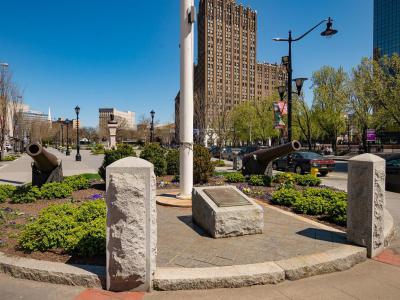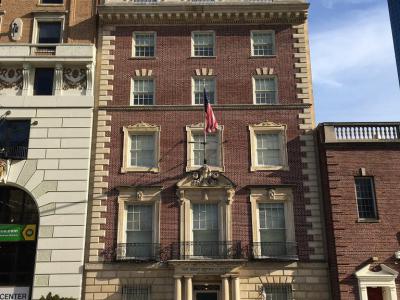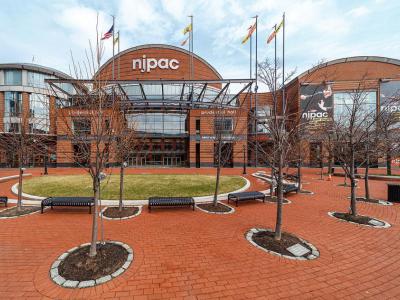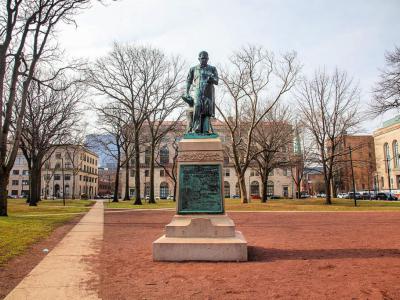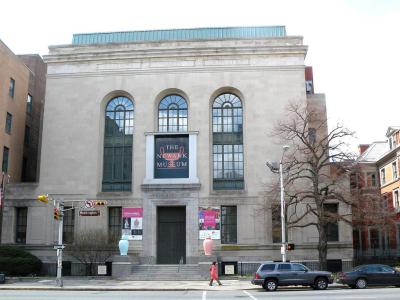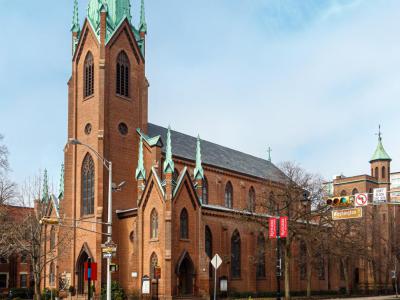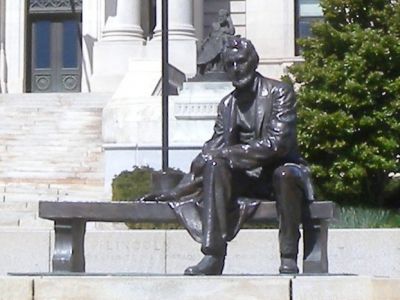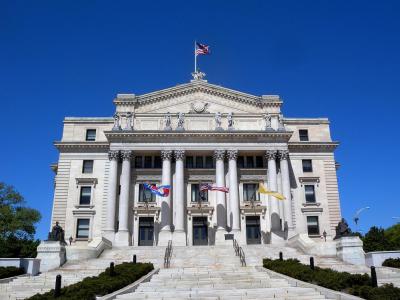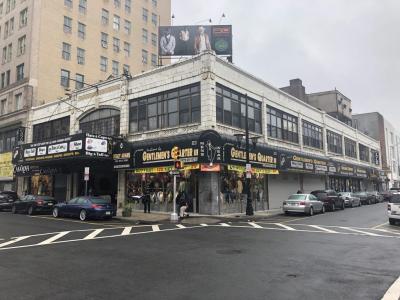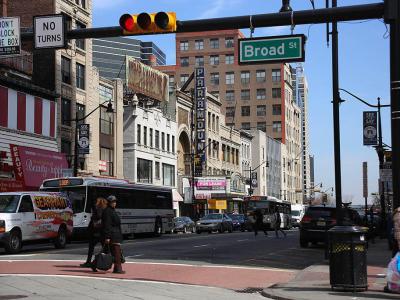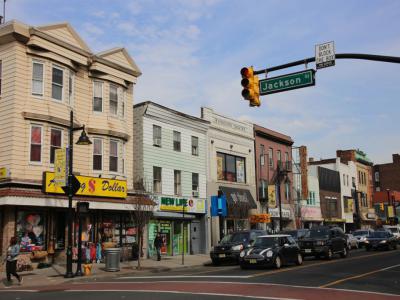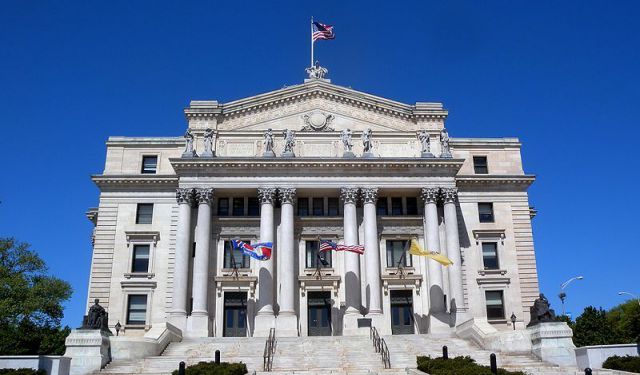Newark Introduction Walking Tour (Self Guided), Newark
Newark, the most populous city of New Jersey, is also one of the oldest cities in the United States, established in 1666. Settled by Puritans from New Haven Colony, Newark was initially a theocratic community, which diversified as new settlers introduced different ideas.
Named likely after Newark-on-Trent in England, the city's moniker reveals its colonial roots. Alternative theories suggest the name represents a "New Ark of the Covenant" or the settlers' "New Work" with God.
Throughout the 19th and early 20th centuries, Newark experienced significant industrial growth and population increases, further enhanced in the 1990s with significant investments in office spaces, arts, and sports.
Today's Newark unfolds as a compelling tableau of American history, innovation, and cultural vibrancy. Having grown from a small Puritan settlement into New Jersey's largest metropolis, it embodies a rich narrative that mirrors the broader American experience.
Notable sites like Military Park, once a training ground for soldiers and now a revitalized public space, and the New Jersey Historical Society, which houses an extensive collection of artifacts, underscore Newark’s commitment to preserving its history.
Cultural enthusiasts will find a hub of artistic expression at the New Jersey Performing Arts Center (NJPAC), one of the largest performing arts venues in the United States, offering a diverse array of performances that highlight both local talent and international stars.
The Newark Museum of Art, another jewel in the city's cultural crown, offers an expansive collection that ranges from American art to decorative arts, providing insights into the regional and national artistic landscape. Nearby, Harriet Tubman Square stands as a powerful tribute to the American abolitionist, reinforcing the city's role in pivotal historical movements.
The intersection of Broad and Market Streets, known as Four Corners, serves as the commercial heartbeat of the city. This historic crossroads, once the busiest intersection in the nation, continues to be a focal point for business and social interaction.
Further enriching Newark’s cultural fabric is the Ironbound district, famous for its vibrant Portuguese community and culinary delights found along Ferry Street.
For those captivated by this blend of history, culture, and community, Newark offers endless avenues to explore and engage. To dive into the vibrant life of the city, and experience the unique spirit that makes Newark a cornerstone of American resilience and renewal, follow this self-guided walk.
Named likely after Newark-on-Trent in England, the city's moniker reveals its colonial roots. Alternative theories suggest the name represents a "New Ark of the Covenant" or the settlers' "New Work" with God.
Throughout the 19th and early 20th centuries, Newark experienced significant industrial growth and population increases, further enhanced in the 1990s with significant investments in office spaces, arts, and sports.
Today's Newark unfolds as a compelling tableau of American history, innovation, and cultural vibrancy. Having grown from a small Puritan settlement into New Jersey's largest metropolis, it embodies a rich narrative that mirrors the broader American experience.
Notable sites like Military Park, once a training ground for soldiers and now a revitalized public space, and the New Jersey Historical Society, which houses an extensive collection of artifacts, underscore Newark’s commitment to preserving its history.
Cultural enthusiasts will find a hub of artistic expression at the New Jersey Performing Arts Center (NJPAC), one of the largest performing arts venues in the United States, offering a diverse array of performances that highlight both local talent and international stars.
The Newark Museum of Art, another jewel in the city's cultural crown, offers an expansive collection that ranges from American art to decorative arts, providing insights into the regional and national artistic landscape. Nearby, Harriet Tubman Square stands as a powerful tribute to the American abolitionist, reinforcing the city's role in pivotal historical movements.
The intersection of Broad and Market Streets, known as Four Corners, serves as the commercial heartbeat of the city. This historic crossroads, once the busiest intersection in the nation, continues to be a focal point for business and social interaction.
Further enriching Newark’s cultural fabric is the Ironbound district, famous for its vibrant Portuguese community and culinary delights found along Ferry Street.
For those captivated by this blend of history, culture, and community, Newark offers endless avenues to explore and engage. To dive into the vibrant life of the city, and experience the unique spirit that makes Newark a cornerstone of American resilience and renewal, follow this self-guided walk.
How it works: Download the app "GPSmyCity: Walks in 1K+ Cities" from Apple App Store or Google Play Store to your mobile phone or tablet. The app turns your mobile device into a personal tour guide and its built-in GPS navigation functions guide you from one tour stop to next. The app works offline, so no data plan is needed when traveling abroad.
Newark Introduction Walking Tour Map
Guide Name: Newark Introduction Walking Tour
Guide Location: USA » Newark (See other walking tours in Newark)
Guide Type: Self-guided Walking Tour (Sightseeing)
# of Attractions: 11
Tour Duration: 2 Hour(s)
Travel Distance: 3.4 Km or 2.1 Miles
Author: leticia
Sight(s) Featured in This Guide:
Guide Location: USA » Newark (See other walking tours in Newark)
Guide Type: Self-guided Walking Tour (Sightseeing)
# of Attractions: 11
Tour Duration: 2 Hour(s)
Travel Distance: 3.4 Km or 2.1 Miles
Author: leticia
Sight(s) Featured in This Guide:
- Military Park
- New Jersey Historical Society
- New Jersey Performing Arts Center (NJPAC)
- Harriet Tubman Square
- Newark Museum of Art
- Pro-Cathedral of Saint Patrick
- Lincoln Post Memorial
- Essex County Courthouse
- Halsey Street
- Four Corners (Broad and Market Streets)
- Ironbound and Ferry Street
1) Military Park
Historic Military Park, located in downtown Newark, serves as a central gathering space for the community and visitors. Established as the original Middle Commons when Newark was founded in 1666, the park spans six acres and is bounded by Broad Street, Park Place, and Rector Street. Designed by Robert Treat, the park has a rich history, initially serving as a training ground visible on maps dating back to 1667. It played a significant role during the French and Indian War and later became a campground for George Washington’s troops during the American Revolution.
After the war, the Commons was transformed into a public park, although it briefly returned to its military roots during the War of 1812. The park continued its military legacy by serving as a recruitment site during the Civil War and as a hub for Red Cross and Liberty Loans campaigns during World War I.
In recent years, Military Park has undergone revitalization and now serves as a vibrant town square. It attracts a diverse array of visitors, including children, adults, local residents, office workers, and students. The park is surrounded by cultural institutions such as the New Jersey Performing Arts Center, WBGO Jazz station, historic Trinity and St. Philip’s Cathedral, the New Jersey Historical Society, the Newark Visitors Center, and numerous retail shops and restaurants in the Halsey Street district. This revitalization has transformed the park into a lively, dynamic space that reflects the community's rich history and contemporary culture.
Within the park, visitors can enjoy a meal at The Yard, ride the carousel, or explore the various monuments and public art installations scattered throughout. The park's blend of historical legacy and modern amenities ensures it remains a vital and engaging space for all who visit.
After the war, the Commons was transformed into a public park, although it briefly returned to its military roots during the War of 1812. The park continued its military legacy by serving as a recruitment site during the Civil War and as a hub for Red Cross and Liberty Loans campaigns during World War I.
In recent years, Military Park has undergone revitalization and now serves as a vibrant town square. It attracts a diverse array of visitors, including children, adults, local residents, office workers, and students. The park is surrounded by cultural institutions such as the New Jersey Performing Arts Center, WBGO Jazz station, historic Trinity and St. Philip’s Cathedral, the New Jersey Historical Society, the Newark Visitors Center, and numerous retail shops and restaurants in the Halsey Street district. This revitalization has transformed the park into a lively, dynamic space that reflects the community's rich history and contemporary culture.
Within the park, visitors can enjoy a meal at The Yard, ride the carousel, or explore the various monuments and public art installations scattered throughout. The park's blend of historical legacy and modern amenities ensures it remains a vital and engaging space for all who visit.
2) New Jersey Historical Society
The New Jersey Historical Society, located in the former Essex Club headquarters, is a vital institution dedicated to preserving and presenting the state's rich history. The Society's building, a Georgian-style structure designed by Guilbert & Betelle and built in 1926, is listed on the National Register of Historic Places. It features two floors of exhibition space, a gift shop, and a lecture hall, providing a comprehensive cultural and educational experience.
The New Jersey Historical Society houses exhibitions on the second and third floors, showcasing various aspects of the state's history and heritage. The library reading room, located on the fifth floor, was formerly the Essex Club's squash courts and provides a unique setting for research and study. The library is open to the public, although patrons are encouraged to make appointments. While members enjoy free admission, non-members are required to pay a fee to access the Society's resources and exhibitions.
Founded in 1845 in Trenton by intellectual and business leaders such as Joseph C. Hornblower, Peter D. Vroom, and William Whitehead, the Society has a long and storied history. Its original Newark headquarters were on Market Street, but in 1931, it moved to a colonial-style building funded in part by philanthropist Louis Bamberger, located on Broadway. This move marked a significant expansion of the Society's capacity to house and display its growing collection of historical artifacts and documents.
In 1997, the Historical Society made a significant return to downtown Newark, relocating to 52 Park Place on Military Park. This move to the historic Essex Club building greatly increased the Society's visibility and accessibility, resulting in a nearly fivefold increase in visits within the first year. Today, the New Jersey Historical Society continues to serve as a crucial repository of the state's history, offering educational programs, exhibitions, and resources that enrich the understanding of New Jersey's past and its ongoing impact on the present.
The New Jersey Historical Society houses exhibitions on the second and third floors, showcasing various aspects of the state's history and heritage. The library reading room, located on the fifth floor, was formerly the Essex Club's squash courts and provides a unique setting for research and study. The library is open to the public, although patrons are encouraged to make appointments. While members enjoy free admission, non-members are required to pay a fee to access the Society's resources and exhibitions.
Founded in 1845 in Trenton by intellectual and business leaders such as Joseph C. Hornblower, Peter D. Vroom, and William Whitehead, the Society has a long and storied history. Its original Newark headquarters were on Market Street, but in 1931, it moved to a colonial-style building funded in part by philanthropist Louis Bamberger, located on Broadway. This move marked a significant expansion of the Society's capacity to house and display its growing collection of historical artifacts and documents.
In 1997, the Historical Society made a significant return to downtown Newark, relocating to 52 Park Place on Military Park. This move to the historic Essex Club building greatly increased the Society's visibility and accessibility, resulting in a nearly fivefold increase in visits within the first year. Today, the New Jersey Historical Society continues to serve as a crucial repository of the state's history, offering educational programs, exhibitions, and resources that enrich the understanding of New Jersey's past and its ongoing impact on the present.
3) New Jersey Performing Arts Center (NJPAC)
The New Jersey Performing Arts Center (NJPAC) is one of the largest and most prominent performing arts centers in the United States. Since its grand opening in October 1997, NJPAC has welcomed over 6 million visitors, including more than one million children. It serves as the home of the Grammy Award-winning New Jersey Symphony Orchestra (NJSO) and has played a significant role in the revitalization of New Jersey's largest city.
Construction of NJPAC began in 1995 and was completed in 1997, with the center receiving critical acclaim upon its opening. The New York Times architecture critic Herbert Muschamp lauded the building's design, while The New Yorker praised its concert halls as some of the best on the Eastern Seaboard, highlighting their handsome appearance and warm acoustics.
Today, NJPAC continues to be a beacon of culture and education, attracting a diverse audience and offering a rich array of performances and programs. Its contributions to the arts and the community have made it a cornerstone of Newark's cultural landscape, providing a space where creativity and learning thrive.
Chambers Plaza, the front lawn of NJPAC, is undergoing a transformation into a vibrant, four-season urban park in 2024. The redesigned Plaza will feature the new Essex County Green, a rain garden, enhanced lighting, and versatile seating options. These improvements will facilitate year-round activities, such as performances, markets, and classes. The new Chambers Plaza is designed by the Brooklyn-based landscape architecture studio Future Green.
Construction of NJPAC began in 1995 and was completed in 1997, with the center receiving critical acclaim upon its opening. The New York Times architecture critic Herbert Muschamp lauded the building's design, while The New Yorker praised its concert halls as some of the best on the Eastern Seaboard, highlighting their handsome appearance and warm acoustics.
Today, NJPAC continues to be a beacon of culture and education, attracting a diverse audience and offering a rich array of performances and programs. Its contributions to the arts and the community have made it a cornerstone of Newark's cultural landscape, providing a space where creativity and learning thrive.
Chambers Plaza, the front lawn of NJPAC, is undergoing a transformation into a vibrant, four-season urban park in 2024. The redesigned Plaza will feature the new Essex County Green, a rain garden, enhanced lighting, and versatile seating options. These improvements will facilitate year-round activities, such as performances, markets, and classes. The new Chambers Plaza is designed by the Brooklyn-based landscape architecture studio Future Green.
4) Harriet Tubman Square
Harriet Tubman Square is a historic public space located on land that was once part of the Munsee-speaking Lunaape (Lenape) people's territory. The park's origins date back to 1667 when Puritan settlers designated the land as a commons for grazing sheep and marketing goods, initially referred to as "North Common" or "Upper Green." In 1795, the town voted unanimously to transform the commons into a park, naming it after George Washington.
Over the next two centuries, the park became surrounded by significant cultural and civic institutions, including The Newark Museum of Art, the Newark Public Library, the Ballantine Mansion, and Rutgers Business School. In 1978, the park and its surrounding neighborhood were designated the Historic James St. Commons and added to the National Register of Historical Places, making it the city's first historic district.
Throughout its history, Harriet Tubman Square has been the site of various public statues installed during different periods. In 1926, Newark’s Italian American community gifted a statue of Christopher Columbus to the city, which was installed in the park the following year. However, in June 2020, amid a reevaluation of historical figures and their legacies, the Columbus statue was removed and relocated to St. Lucy’s Church.
In 2022, to celebrate the Juneteenth holiday, also known as "Emancipation Day," the park was renamed Harriet Tubman Square. This renaming honors the under-recognized histories of African Americans and abolitionists who contributed to the quest for liberation and justice in the United States, acknowledging New Jersey's complex history as the last Northern state to legally abolish slavery in 1866.
Today Harriet Tubman Square continues to serve as a vital town gathering place, reflecting its historic role.
Over the next two centuries, the park became surrounded by significant cultural and civic institutions, including The Newark Museum of Art, the Newark Public Library, the Ballantine Mansion, and Rutgers Business School. In 1978, the park and its surrounding neighborhood were designated the Historic James St. Commons and added to the National Register of Historical Places, making it the city's first historic district.
Throughout its history, Harriet Tubman Square has been the site of various public statues installed during different periods. In 1926, Newark’s Italian American community gifted a statue of Christopher Columbus to the city, which was installed in the park the following year. However, in June 2020, amid a reevaluation of historical figures and their legacies, the Columbus statue was removed and relocated to St. Lucy’s Church.
In 2022, to celebrate the Juneteenth holiday, also known as "Emancipation Day," the park was renamed Harriet Tubman Square. This renaming honors the under-recognized histories of African Americans and abolitionists who contributed to the quest for liberation and justice in the United States, acknowledging New Jersey's complex history as the last Northern state to legally abolish slavery in 1866.
Today Harriet Tubman Square continues to serve as a vital town gathering place, reflecting its historic role.
5) Newark Museum of Art (must see)
The Newark Museum of Art, the largest museum in New Jersey, boasts an impressive array of collections, including American art, decorative arts, contemporary art, and arts from Asia, Africa, the Americas, and the ancient world. The museum's Tibetan galleries, among the finest globally, feature a collection acquired from Christian missionaries in the early 20th century. A standout in these galleries is an in-situ Buddhist altar, consecrated by the Dalai Lama, offering visitors a deeply immersive cultural experience.
Beyond its rich art collections, The Newark Museum of Art is also dedicated to the natural sciences. It houses the Dreyfuss Planetarium and the Victoria Hall of Science, which showcases some of the museum's 70,000-specimen Natural Science Collection. These exhibits provide educational and engaging experiences for visitors of all ages, highlighting the museum's commitment to interdisciplinary learning and exploration.
The museum's grounds include the Alice Ransom Dreyfuss Memorial Garden, a vibrant space for community programs, concerts, and performances. This garden also features a historic 1784 old stone schoolhouse and the Fire Safety Center, further enriching the museum's offerings. Organized in 1909 by esteemed Newark librarian John Cotton Dana, the museum's initial collection stemmed from Japanese prints, silks, and porcelains gathered by a local pharmacist.
Beyond its rich art collections, The Newark Museum of Art is also dedicated to the natural sciences. It houses the Dreyfuss Planetarium and the Victoria Hall of Science, which showcases some of the museum's 70,000-specimen Natural Science Collection. These exhibits provide educational and engaging experiences for visitors of all ages, highlighting the museum's commitment to interdisciplinary learning and exploration.
The museum's grounds include the Alice Ransom Dreyfuss Memorial Garden, a vibrant space for community programs, concerts, and performances. This garden also features a historic 1784 old stone schoolhouse and the Fire Safety Center, further enriching the museum's offerings. Organized in 1909 by esteemed Newark librarian John Cotton Dana, the museum's initial collection stemmed from Japanese prints, silks, and porcelains gathered by a local pharmacist.
6) Pro-Cathedral of Saint Patrick
The Pro-Cathedral of Saint Patrick in Newark, built in 1846, holds a significant place in the history of the Roman Catholic Church in the United States. Originally serving as the seat of the prelate bishop until the completion of the Basilica of the Sacred Heart on Clifton Avenue, this historic church continues to be an active and vibrant parish.
Listed on the National Register of Historic Places, the Pro-Cathedral has undergone extensive rehabilitation over the past fifteen years following a period of declining membership. This revitalization has allowed the parish to preserve its historic traditions and maintain its role as the "Old Cathedral" of Newark. Among these traditions are the 12:15 Ash Wednesday Liturgy with the Archbishop, the 12:15 Sunday Liturgy on Easter in memory of the 1916 Easter Rising in Dublin, and the annual Newark Fire Department memorial Mass. The church also hosts various archdiocesan and Irish-heritage events, reflecting its deep-rooted connections to the local community and its heritage.
The Pro-Cathedral of Saint Patrick is also the national shrine to Our Lady of Quinche, further enhancing its spiritual and cultural significance. The parish's commitment to honoring its history while serving the contemporary needs of its congregation is evident in its vibrant liturgical schedule and active community involvement.
Listed on the National Register of Historic Places, the Pro-Cathedral has undergone extensive rehabilitation over the past fifteen years following a period of declining membership. This revitalization has allowed the parish to preserve its historic traditions and maintain its role as the "Old Cathedral" of Newark. Among these traditions are the 12:15 Ash Wednesday Liturgy with the Archbishop, the 12:15 Sunday Liturgy on Easter in memory of the 1916 Easter Rising in Dublin, and the annual Newark Fire Department memorial Mass. The church also hosts various archdiocesan and Irish-heritage events, reflecting its deep-rooted connections to the local community and its heritage.
The Pro-Cathedral of Saint Patrick is also the national shrine to Our Lady of Quinche, further enhancing its spiritual and cultural significance. The parish's commitment to honoring its history while serving the contemporary needs of its congregation is evident in its vibrant liturgical schedule and active community involvement.
7) Lincoln Post Memorial
In front of the Essex County Courthouse stands the Lincoln Post Memorial, featuring a statue of Abraham Lincoln, the 16th President of the United States. This remarkable sculpture was created by Gutzon Borglum, the artist renowned for carving the iconic heads of four U.S. presidents at Mount Rushmore. The bronze sculpture depicts Lincoln seated at one end of a bench, larger than life size, with his bearded face reflecting a contemplative demeanor. His signature stovepipe hat rests beside him, emphasizing an informal and approachable portrayal that diverges from the traditional, monumental depictions of Lincoln.
The inspiration for this unique composition came from Borglum's research, which revealed that Lincoln often sat alone on a bench in the White House garden to gather his thoughts during the Civil War, especially during times of distress. This setting influenced Borglum to create a statue that captures a moment of quiet reflection, humanizing the president. The bronze statue is set on a low stone platform with five steps, positioned near the steps of the courthouse, inviting passersby to engage with Lincoln's likeness in a more personal manner.
The Lincoln Post Memorial was funded by a $25,000 bequest from Newark businessman Amos Hoagland Van Horn, who passed away in 1908. The sculpture was cast at the Gorham Manufacturing Company foundry in New York and was dedicated by President Theodore Roosevelt on Memorial Day, May 30, 1911. During the dedication, Roosevelt remarked, "Why this doesn't look like a monument at all!"-a comment that Borglum interpreted as high praise, as it confirmed his intention to create a piece that felt accessible and relatable rather than grandiose.
The inspiration for this unique composition came from Borglum's research, which revealed that Lincoln often sat alone on a bench in the White House garden to gather his thoughts during the Civil War, especially during times of distress. This setting influenced Borglum to create a statue that captures a moment of quiet reflection, humanizing the president. The bronze statue is set on a low stone platform with five steps, positioned near the steps of the courthouse, inviting passersby to engage with Lincoln's likeness in a more personal manner.
The Lincoln Post Memorial was funded by a $25,000 bequest from Newark businessman Amos Hoagland Van Horn, who passed away in 1908. The sculpture was cast at the Gorham Manufacturing Company foundry in New York and was dedicated by President Theodore Roosevelt on Memorial Day, May 30, 1911. During the dedication, Roosevelt remarked, "Why this doesn't look like a monument at all!"-a comment that Borglum interpreted as high praise, as it confirmed his intention to create a piece that felt accessible and relatable rather than grandiose.
8) Essex County Courthouse
The Essex County Courthouse stands as a monumental centerpiece in the heart of Newark. Constructed in 1906 by the Piccirilli Brothers with designs by renowned architect Cass Gilbert, the courthouse exemplifies the Renaissance architectural style. Its grandeur is highlighted by fine marble columns, ornate decorations, and a striking glass-domed roof, all contributing to its status as a historic and architectural landmark.
Upon approaching the main entrance, visitors are greeted by statues symbolizing "Truth" and "Power," flanking the entryway. These sculptures set the tone for the courthouse's solemn purpose, embodying the principles of justice and authority that the building represents. Additionally, nine allegorical statues grace the pediment above, each embodying various virtues and concepts central to the judicial system and civic life.
Inside, the courthouse's elegance continues with intricate details and craftsmanship evident throughout its halls and chambers. The use of fine marble and other luxurious materials reflects the significance of the courthouse as a center of justice and governance for Essex County. The glass-domed roof allows natural light to illuminate the interior, adding to the building's majestic atmosphere and providing a sense of openness and transparency.
The Essex County Courthouse not only serves as a functional space for legal proceedings but also stands as a testament to early 20th-century architectural excellence. Its design and construction have made it a notable landmark in Newark, attracting visitors and history enthusiasts alike.
Upon approaching the main entrance, visitors are greeted by statues symbolizing "Truth" and "Power," flanking the entryway. These sculptures set the tone for the courthouse's solemn purpose, embodying the principles of justice and authority that the building represents. Additionally, nine allegorical statues grace the pediment above, each embodying various virtues and concepts central to the judicial system and civic life.
Inside, the courthouse's elegance continues with intricate details and craftsmanship evident throughout its halls and chambers. The use of fine marble and other luxurious materials reflects the significance of the courthouse as a center of justice and governance for Essex County. The glass-domed roof allows natural light to illuminate the interior, adding to the building's majestic atmosphere and providing a sense of openness and transparency.
The Essex County Courthouse not only serves as a functional space for legal proceedings but also stands as a testament to early 20th-century architectural excellence. Its design and construction have made it a notable landmark in Newark, attracting visitors and history enthusiasts alike.
9) Halsey Street
Halsey Street traces its origins back to the city's early settlement days in 1666, when it was part of the original plots distributed among Newark's first settlers. The street itself was formally established during the early 19th century, coinciding with a period of significant urban expansion. Named after William Halsey, Newark's first mayor after its reincorporation as a city in the 1830s, Halsey Street has played a pivotal role in the city's development.
During Newark's Gilded Age and the early 20th century boom, Halsey Street underwent a transformation from residential to commercial hub. The era saw the replacement of low-rise homes with new commercial buildings, including iconic department stores like Hahne and Company, Bamberger's, and S. Klein, solidifying Halsey Street as a major commercial corridor in Newark.
In recent decades, Halsey Street has experienced a revitalization. Beginning in the 2000s with initiatives like the city's Living Downtown master plan, the street has seen renewed interest in residential, cultural, and commercial development. This resurgence has transformed Halsey Street into a vibrant area known for its diverse array of small independent businesses, restaurants, arts venues, and nightlife spots. The introduction of incentives in 2023 aimed at stimulating storefront rentals along Halsey and neighboring streets further underscores the city's commitment to fostering a lively and economically thriving downtown area.
Today, Halsey Street remains a blend of historical charm and contemporary vibrancy, reflecting Newark's rich history while embracing its future as a cultural and commercial destination in New Jersey.
During Newark's Gilded Age and the early 20th century boom, Halsey Street underwent a transformation from residential to commercial hub. The era saw the replacement of low-rise homes with new commercial buildings, including iconic department stores like Hahne and Company, Bamberger's, and S. Klein, solidifying Halsey Street as a major commercial corridor in Newark.
In recent decades, Halsey Street has experienced a revitalization. Beginning in the 2000s with initiatives like the city's Living Downtown master plan, the street has seen renewed interest in residential, cultural, and commercial development. This resurgence has transformed Halsey Street into a vibrant area known for its diverse array of small independent businesses, restaurants, arts venues, and nightlife spots. The introduction of incentives in 2023 aimed at stimulating storefront rentals along Halsey and neighboring streets further underscores the city's commitment to fostering a lively and economically thriving downtown area.
Today, Halsey Street remains a blend of historical charm and contemporary vibrancy, reflecting Newark's rich history while embracing its future as a cultural and commercial destination in New Jersey.
10) Four Corners (Broad and Market Streets)
The Four Corners Historic District, centered at the intersection of Broad and Market Streets, marks the city's earliest settlement and remains the heart of Downtown Newark. This historically significant crossroads, at one time considered the busiest intersection in the United States, reflects the city's rich heritage and dynamic growth. Encompassing twenty-two square blocks, the area is recognized as a state and federal historic district, preserving its legacy for future generations.
Established in 1666, the intersection quickly became the town's center, with founder Robert Treat's home located at the southwest corner. This location served as the focal point for Newark's development, with the city expanding around this central hub. Over the centuries, Broad and Market Streets evolved into major thoroughfares, reinforcing the importance of Four Corners as the primary intersection for both north-south and east-west travel.
The historical significance of Four Corners extends beyond its early settlement roots. The intersection has continuously been a bustling center of commerce and activity, influencing the city's planning and growth since its inception. Its designation as one of the busiest intersections in the country underscores its role in shaping Newark's urban landscape and facilitating its economic and social development.
Established in 1666, the intersection quickly became the town's center, with founder Robert Treat's home located at the southwest corner. This location served as the focal point for Newark's development, with the city expanding around this central hub. Over the centuries, Broad and Market Streets evolved into major thoroughfares, reinforcing the importance of Four Corners as the primary intersection for both north-south and east-west travel.
The historical significance of Four Corners extends beyond its early settlement roots. The intersection has continuously been a bustling center of commerce and activity, influencing the city's planning and growth since its inception. Its designation as one of the busiest intersections in the country underscores its role in shaping Newark's urban landscape and facilitating its economic and social development.
11) Ironbound and Ferry Street (must see)
The roots of today’s Ironbound neighborhood in Newark, trace back to the 19th-century transformation of the region into one of the nation’s first industrial corridors. This transition began with Alexander Hamilton, the first U.S. Secretary of the Treasury, who co-founded the Society for Establishing Useful Manufactures in 1792. The Society purchased 700 acres of land around New Jersey’s largest waterfall to establish the city of Paterson. Hamilton envisioned this city as a "New National Manufactory" that would drive the U.S. towards economic independence by fostering a shift from an agricultural to a manufacturing economy.
By the 1970s, the Portuguese community became the dominant ethnic group in Ironbound, following Portugal's "flower revolution" which ended the dictatorship of Antonio Salazar. The influx of Portuguese immigrants turned Ironbound into a vibrant center for the Portuguese diaspora in the U.S., earning it the nickname "Little Portugal." Throughout its history, Ironbound has been a mosaic of ethnic identities and cultural traditions, showcasing how diverse communities can coexist and enrich a multicultural society.
The mile-long stretch of Ferry Street, extending from Penn Station to St. Stephan’s Grace Community Church, forms the spine of Ironbound. Originally chartered in 1765 as Old Ferry Road, it was designed to connect ferries transporting goods and people from Manhattan and Jersey City to Newark’s marketplace. Over the years, Ferry Street has been a gateway for newcomers, providing a starting point for many immigrants to begin their new lives.
Today, Ferry Street is synonymous with food, particularly Iberian cuisine, which has attracted visitors and bolstered the local economy since the 1970s. More recently, immigrants from Latin American countries have diversified the culinary landscape, adding new flavors and cultural dimensions to the neighborhood. The rich tapestry of restaurants and eateries along Ferry Street not only showcases the diverse food offerings but also reflects the complex histories and memories of the Ironbound community. This vibrant food scene, coupled with the historical narratives of the buildings housing these establishments, tells the story of Ironbound's past and the resilient spirit of its people.
By the 1970s, the Portuguese community became the dominant ethnic group in Ironbound, following Portugal's "flower revolution" which ended the dictatorship of Antonio Salazar. The influx of Portuguese immigrants turned Ironbound into a vibrant center for the Portuguese diaspora in the U.S., earning it the nickname "Little Portugal." Throughout its history, Ironbound has been a mosaic of ethnic identities and cultural traditions, showcasing how diverse communities can coexist and enrich a multicultural society.
The mile-long stretch of Ferry Street, extending from Penn Station to St. Stephan’s Grace Community Church, forms the spine of Ironbound. Originally chartered in 1765 as Old Ferry Road, it was designed to connect ferries transporting goods and people from Manhattan and Jersey City to Newark’s marketplace. Over the years, Ferry Street has been a gateway for newcomers, providing a starting point for many immigrants to begin their new lives.
Today, Ferry Street is synonymous with food, particularly Iberian cuisine, which has attracted visitors and bolstered the local economy since the 1970s. More recently, immigrants from Latin American countries have diversified the culinary landscape, adding new flavors and cultural dimensions to the neighborhood. The rich tapestry of restaurants and eateries along Ferry Street not only showcases the diverse food offerings but also reflects the complex histories and memories of the Ironbound community. This vibrant food scene, coupled with the historical narratives of the buildings housing these establishments, tells the story of Ironbound's past and the resilient spirit of its people.
Walking Tours in Newark, New Jersey
Create Your Own Walk in Newark
Creating your own self-guided walk in Newark is easy and fun. Choose the city attractions that you want to see and a walk route map will be created just for you. You can even set your hotel as the start point of the walk.
Newark's Historical Buildings Walking Tour
Founded in 1666, Newark has no shortage of historic locations: districts, buildings, parks, cemeteries, and other venues. Much of its old-time architecture are notable sites listed on the National Register of Historic Places.
One such is the Essex County Courthouse, a striking example of Renaissance architecture, built in 1904. This grand building, with its impressive marble columns, ornate... view more
Tour Duration: 2 Hour(s)
Travel Distance: 2.8 Km or 1.7 Miles
One such is the Essex County Courthouse, a striking example of Renaissance architecture, built in 1904. This grand building, with its impressive marble columns, ornate... view more
Tour Duration: 2 Hour(s)
Travel Distance: 2.8 Km or 1.7 Miles
The Most Popular Cities
/ view all



